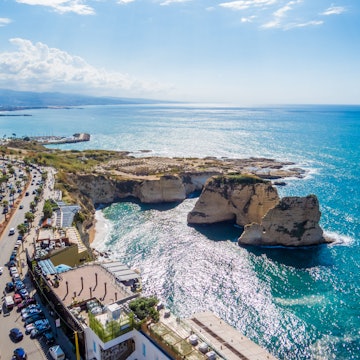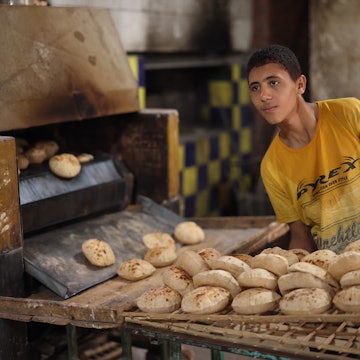

Get lost in the Roman ruins at Baalbek. Vadim_N / Shutterstock
For a country its small size, Lebanon has a staggering number of diversions to keep visitors entertained. Ancient history enthusiasts will be exhausted by the end of their trip: you can barely turn around without stumbling over a world-class archaeological site. Lovers of nightlife will find a gregarious capital with bacchanalian parties going to all hours. Those seeking serene nature can wander through ancient cedar forests and dramatic mountainscapes.
Here's where to go and what to do if you're headed to Lebanon for the first time.

Beirut
Beirut is a city of atmosphere rather than world-class sights. Explore the city on foot, and take your time. Whether you encounter a decaying Ottoman-era mansion covered in bougainvillea (and sometimes decades-old bullet holes from the Lebanese Civil War), a couple at the table next to you at happy hour who insist you share their nachos or an elderly taxi driver with a luxurious moustache who sings old Arabic songs a cappella at full volume: this is a city where small moments loom large.
Ancient history fans should visit the National Museum of Beirut or the St George Crypt Museum for artefacts and a window into life in ancient Berytus, the centre of Roman legal thought. Wander the neighbourhood of Hamra, stopping at used book shops and a cafe (try T Marbouta) for an Arabic coffee, and then check out the American University of Beirut campus for greenery, new feline pals and a diverse mix of architectural styles. Stroll down to the Corniche, Beirut’s great common denominator, to watch the sun set on the Mediterranean (Bay Rock Cafe has great views over Pigeon Rocks). For dinner, head to Gemmayzeh for cheap and cheerful Lebanese mezze at Café Em Nazih and obligatory after-dinner drinks at Coop d’Etat, the rooftop bar upstairs.
Bekaa Valley
One of the breadbaskets of ancient Rome, the Bekaa Valley is littered with ancient sites. The world-class ruins of Baalbek, site of the Roman solar cult Heliopolis, are the valley’s star attraction. The soaring Temple of Bacchus, circa 200 AD, is one of the best preserved and most majestic Roman ruins in the world, featuring more than a dozen 19m-high columns and exquisitely preserved reliefs. After a day of tramping over ruins, find refreshment at one of many wineries in the mountains separating the Bekaa from the coast, located on the highway back to Beirut. The proprietors of Chateau Ksara and Domaine des Tourelles disagree over which was the first in Lebanon to mass-produce wine and arak (Lebanon’s national aniseed-flavoured distilled spirit); consider both sides of the debate while watching the setting sun cast pink light over the Anti-Lebanon range.
Some governments have travel advisories in place for this region, and the UK's Foreign and Commonwealth Office warns against all non-essential travel to Baalbek.

Northern Lebanon
Tripoli, only two hours from Beirut, is the country’s second-most populous city. It’s bursting with fantastic and varied historic and cultural sites, and Tripolitans may be the most welcoming in all of Lebanon. Inconceivably, few visitors make the trip because there is little official tourist infrastructure. Don’t make the same mistake: what Tripoli lacks in malls and museums, it more than makes up for in ambience.
Start your day at the unfinished Oscar Niemeyer International Fairground, a deserted mid-20th century monument to Brutalist architecture. Continue on to the medieval souqs, still bustling centuries later. Ask locals for directions to the hammam and Madrasa Al Nouriyat, some of the best examples of black-and-white marble-striped Mamluk architecture outside of Cairo. Press on to Tripoli’s Crusader-era Citadel of Raymond de Saint-Gilles, or call it a day and enjoy a well-deserved libation in the Christian port quarter of Al Mina, fragrant with frangipani trees.

The Qadisha Valley rends a deep gorge from outside Tripoli up to Bcharré, a steepled-dotted town in the shadow of Qornet As Sawda, the highest peak in the Levant. The valley was a refuge for early Christians fleeing persecution, and some of the caves that line the steep walls of the canyon contain mummies dating to the 13th century. Spend the night in Bcharré, then wake up early to hike the steep, forested canyon walls. Don’t miss the nearby Cedars of Lebanon preserve before heading back to Beirut; the thin, high-altitude light filtering through ancient trees imparts a tranquillity you’ll be grateful for once you hit traffic on the coastal highway.
If that all sounds a bit sweaty, head to the Med. Northern Lebanon has some sweet beach towns, where you can pass pleasant hours leaping off rocks and feasting on fish. Chilled-out Batroun is home to the Colonel Brewery, where you can find local craft beer and a sandy beach. Further south, 45 minutes from Beirut, is the ancient port city of Byblos, where the Phoenicians invented the alphabet. Toast their ingenuity with a glass of rosé from the deck at Chez Pepe, where Marlon Brando and Brigitte Bardot used to hang out in the 1960s.
Southern Lebanon
Nowhere is Lebanon’s coastline more enchanting than in the south. Turquoise waters lap golden sand beaches, and sea turtles sometimes can be found surfing gentle waist-high waves. The best beaches in south Lebanon are in Tyre, about two hours south of Beirut. Post up at Cloud 59, the most fashionable of the seaside beach shacks, which serves up ice-cold Almaza and simple food. Turn left from the scene at Cloud 59 and wander down to the Tyre Coast Nature Preserve (one of just a few in Lebanon), home to beach grasses and scuttling crabs.
This being Lebanon, there are also world-class ruins in Tyre, including the world’s largest and best preserved Roman hippodrome, which once seated 20,000 fans of chariot racing. The hippodrome is in the Al Bass complex, as is a reconstructed monumental archway and a legitimately spooky Roman necropolis (peer into the sarcophagi and you might see a skeleton).
An hour north of Tyre is the jolly Sunni town of Saida. There are some excellent sights here, among them a Crusader castle and the fascinating Musée du Savon, but the laid-back vibes in the medieval souqs and on the seaside corniche are the real draw. Get a falafel at Abou Rami and then decamp across the road for a nargileh (flavoured water pipe) with everyone else in town basking in the cool evening breeze off the sea.

Getting around
Regular buses serve Tripoli, Tyre and Saida along the coastal highway (catch buses to Tripoli from Beirut's Dawra Transport Hub and to southern cities from Cola Transport Hub). But outside Lebanon's cities, the best way to see the country is by hiring a car for a road trip, easy to do at Beirut's airport.
Is Lebanon safe?
Western governments advise their citizens to avoid the borders with Israel and Syria and stick to Lebanon's interior and coast. Check your government's travel advice before you go. Street crime is extremely rare: something you drop on the street is almost sure to be there when you come back for it, if someone hasn’t already chased you down the street to return it. Residents in rural areas can be a bit more wary of foreigners than their urban counterparts, but everyone is helpful and kind as long as you are respectful of local norms and dress appropriately (don't show thighs, upper arms or midriffs).







![Photo/File #: 12MP ..Country: Great Britain..Site: Hurst Castle..Caption: 12MP aerial..Image Date: [November 2021?]..Photographer: ExploringWithin MUST CREDIT..Provenance: Watch 2022](https://lp-cms-production.imgix.net/2022-03/GBR%20Hurst%20Castle%20MUST%20CREDIT.JPG?auto=format,compress&q=72&fit=crop&w=360&ar=1:1)





